
Preservation and Restoration
Friends of Sutter’s Fort works every day to fund preservation and restoration efforts at Sutter’s Fort State Historic Park.
The work of preserving structures that are over 100 years old is an ongoing, daily task. Friends of Sutter’s Fort is committed to helping to fund these projects. We have provided critical funding for several major preservation projects valued at nearly $1 million, including the painting of the exterior walls, the restoration of the blacksmith shop and the painting of the interior walls.
Learn more about:
Historic Structures
Sutter’s Fort State Historic Park (SHP) is a historic site that has a great deal of significance to both Sacramento, California and world history and is recognized as both a California Historical Landmark and a National Historic Landmark. Today, people visit Sutter’s Fort from throughout the world to better understand the history that led to the famous Gold Rush, the Bear Flag Revolt and to California becoming part of the United State of America.
The structures of Sutter’s Fort were the first non-Indigenous structures built in Sacramento and the site of the first non-native community in California’s Central Valley.
The Central Building of Sutter’s Fort is a two-story adobe structure built between 1841 and 1843, and it the oldest existing building in Sacramento.
The exterior walls of Sutter’s Fort originally extended farther out than they do today. Sutter built the original fort with walls to be 2.5 feet thick and 15 to 18 feet high. When gold was discovered in 1848, the rush of immigrants to California seeking treasures brought the downfall of Sutter’s empire, and soon the Fort walls were dismantled and all that was left was the Central Building.
In 1891, the Native Sons of the Golden West spearheaded restoration efforts, rebuilding the walls of Sutter’s Fort. Completed in 1893, this restoration effort makes Sutter’s Fort the oldest restored Fort in the United States.
Sutter’s Fort was donated to the State of California, and became part of the California State park System in 1947. Today, the Fort is furnished and reconstructed to reflect its 1846 appearance.
Historic Artifacts
In addition to the historic structures at Sutter’s Fort SHP, Friends of Sutter’s Fort also is committed the preservation of the many artifacts that are part of the Sutter’s Fort Collection. This expansive collection of artifacts is housed both at Sutter’s Fort, and at the State Museums Collections Center, which is also managed by California State Parks.
Artifacts include furniture, tools and artwork, along with thousands of photographs and documents. Due to the difficulty to control the environment in the historic structures of Sutter’s Fort, many of these items are not currently accessible to the public. It is our hope to provide future funding to expand the ability to exhibit these items for public viewing. We also hope to fund efforts to preserve and protect the artifacts.
The Museum Collection
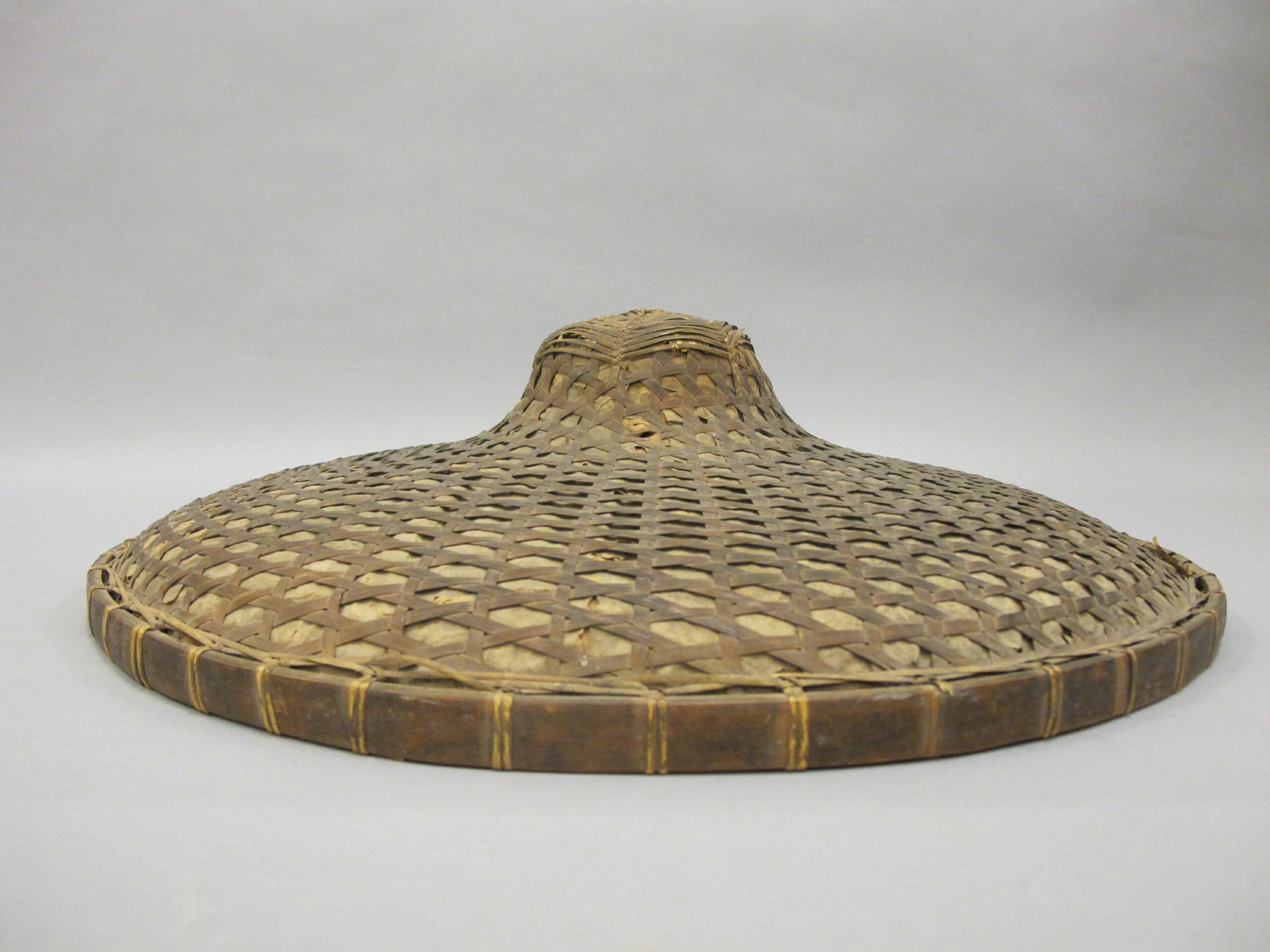
Ah Foo’s Bamboo Hat donated to Sutter’s Fort in 1928
It was through the It attainment of the James Marshall Museum collection from Ms. Kelley that Ah Foo’s hat came into the Sutter’s Fort Collection. In 1928, when the acquisition took place, the Fort collection gained over 2,000 objects from Ms. Kelley, ten of which belonged to Ah Foo. A hat, a pipe, a teapot, a dish for soy Sause, and a few other household items. Some of these items are on display at the Joss House in Weaverville and at Marshall Gold in Coloma today while the rest are kept here at our collection’s facility.
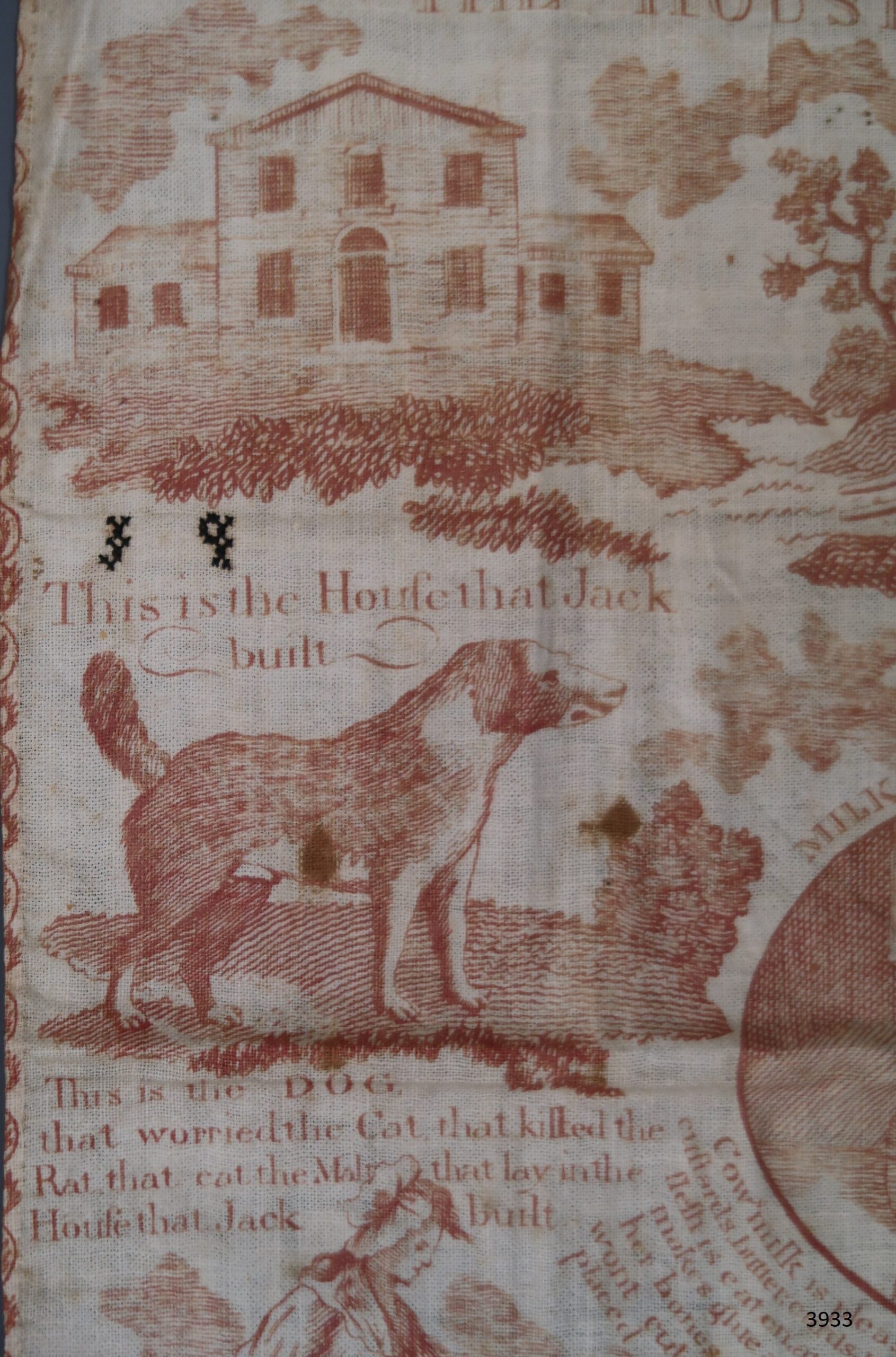
Decorative handkerchief donated to Sutter’s Fort by Harriet Hoyt in 1932
The Sutter’s Fort Curatorial Department is celebrating International Children’s Book Day by drawing your attention to a decorative handkerchief donated to Sutter’s Fort by Harriet Hoyt in 1932.
Recent California State Park Projects
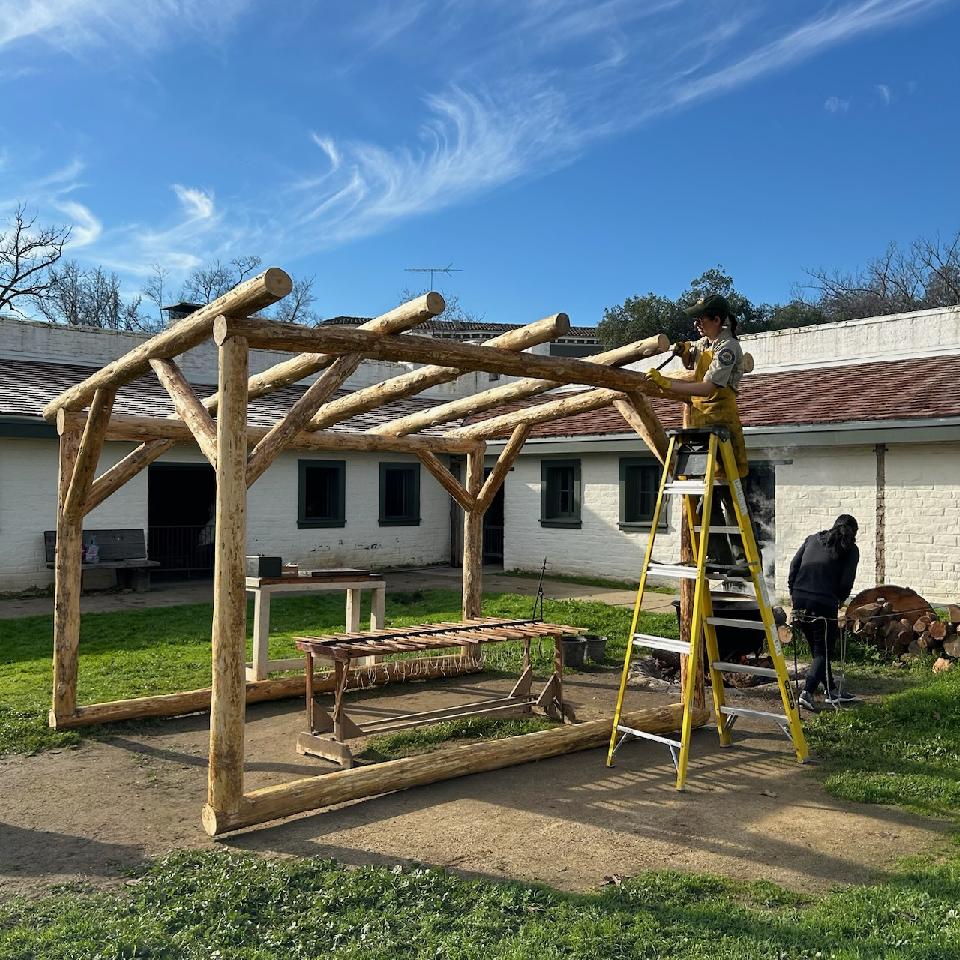
New Shade Structure at Sutter’s Fort
In an effort to enhance visitor comfort and preserve the historical integrity of Sutter’s Fort State Historic Park, California State Parks completed the construction of a new shade structure that will be used primarily for students during field trips as they handmake candles. This project exemplifies a blend of traditional craftsmanship and modern engineering, providing both function and historical representation.
California State Parks Restoration Supervisor Tim White worked closely with park staff to determine the requirements for the new shade structure, with a focus on historical accuracy and durability. Tim designed the structure using traditional saddle joint construction, a method that aligns with the mid-19th century techniques of the Fort’s period of significance.
To source the materials, California State Parks collaborated with Calaveras Big Trees State Park, where they hand-selected the logs needed for the project. Once chosen, Restoration Work Specialist Derek Kettenhofen debarked and prepared the timbers by hand. He meticulously constructed the structure based on Tim’s design, ensuring it reflected historical authenticity.
For added strength and durability, especially given its exposure to the elements and the need for child safety, modern materials such as epoxy, bolts, and structural screws were incorporated into the build. However, all modern reinforcements were carefully hidden behind wooden plugs to maintain the structure’s period-appropriate appearance. The structure’s design and construction were further evaluated by an engineer, ensuring its long-term stability and safety for visitors of all ages.
While a temporary canvas roof was installed to provide immediate shade, the team plans to add a custom canvas roof in the next fiscal year to complete the project.
This successful collaboration between California State Parks, Calaveras Big Trees State Park, and skilled artisans like Tim White and Derek Kettenhofen showcases the dedication and craftsmanship required to preserve the history of the Fort while enhancing for visitor safety and comfort.
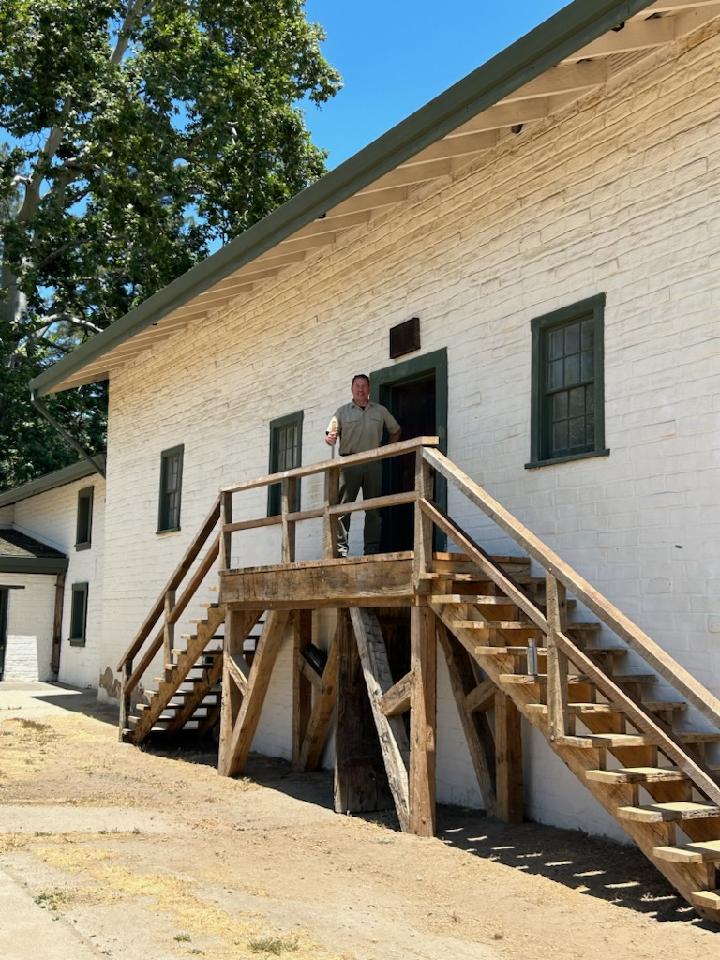
Staircase Restoration Project
In 2023, California State Parks completed the rebuilding of the staircase on the western side of the Central Building at Sutter’s Fort. This project involved the design, construction, and installation of new stairs using reclaimed white oak salvaged from Midwestern barns. The team skillfully combined traditional building techniques with modern advancements, such as concrete post bases, bolts, and contemporary lag screws, ensuring the staircase remains structurally sound while preserving the historical character of the site. All modern materials were carefully concealed to maintain the authentic look and feel of the Fort.
The Central Building is the only original structure remaining at Sutter’s Fort State Historic Park, and over the years, its staircase has been replaced multiple times due to wear and tear. California State Parks took great care in this restoration, honoring the Fort’s legacy while enhancing safety and longevity.
We would like to acknowledge our partners at California State Parks for their dedication to preserving this landmark. Special recognition goes to Restoration Supervisor Tim White, along with Worker I Josh Versemen, Worker I Ian McWhorter, and Restoration Work Specialist Derek Kettenhofen, whose craftsmanship and attention to detail are clearly reflected in the success of this project.
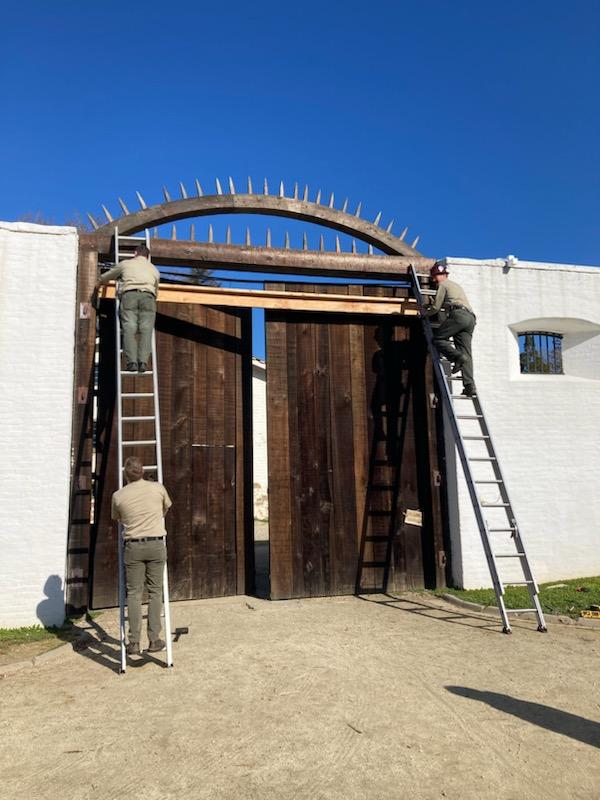
South Gate Spiked Arch Restoration
In 2022, California State Parks took swift action to address a critical issue at the South Gate of Sutter’s Fort State Historic Park. Staff noticed that the arched lintel above the main beam, which secures the large door posts at the Sutter’s Fort south entrance, was leaning, posing a potential safety hazard. To ensure visitor safety, the lintel was immediately removed for inspection and restoration.
Upon removal, the restoration team discovered that the wood was severely rotting. California State Parks restoration specialists secured replacement lumber and began the meticulous process of fabricating a new beam to match the original. Using period-appropriate techniques, the team hand-milled the lumber with saws featuring a tooth pattern typical of the era, and hand-hewed the beams with an adze to replicate the historic appearance.
A particularly striking feature of this project was the recreation of the forty spikes used in the arch. Each spike was individually hand-carved, giving them a unique, handcrafted appearance consistent with the historical period. To further enhance the restoration, a special treatment was applied to the new beam, providing an aged appearance while also offering rot resistance.
In 2023, While the original beam was removed, a temporary support was added to the South Gate to maintain structural integrity. The replacement beam was carefully crafted to match the original mortise and tenon joint configuration, ensuring that the South Gate will remain secure for years to come.
We would like to recognize the exceptional efforts of the California State Parks restoration team on this project. Their dedication to preserving the historic fabric of Sutter’s Fort is evident in the detail and care put into this restoration project.
A New Display Case for Dolly
One of the most famous artifacts on display at the park is Dolly, the small wooden doll carried by Donner Party survivor Martha “Patty” Reed. We are currently fundraising for a new, state of the art, display case that will allow for better temperature and humidity controls, as well as more room to display other objects that tell the story of overland migration.
Friends at Work:
Completed Preservation and Restoration Projects
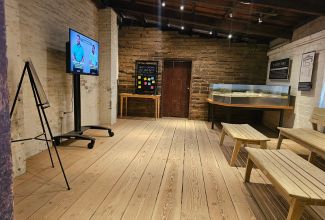
Media Room Renovation: Enhancing Visitor Experience at Sutter’s Fort
In a collaborative effort between California State Parks and Friends of Sutter’s Fort, and with generous support from donors and a Park Improvement Project Grant from the California State Parks Foundation, we are proud to announce the completion of a significant renovation project in the Media Room at Sutter’s Fort State Historic Park.
A Space Transformed for Learning and Exploration
The purpose of this renovation was to transform the Media Room into a central hub for visitors to begin their self-guided tour of Sutter’s Fort SHP. With this project, our goal was to make the room more inviting, educational, and comfortable, enhancing the overall visitor experience.
Collaboration and Historical Preservation
Friends of Sutter’s Fort worked closely with curatorial, interpretive, and administrative staff at California State Parks to design new interpretive signage and create a gallery of historical images that showcase Sutter’s Fort’s transformation over the past 100 years. This gallery allows visitors to see how the Fort evolved, sparking meaningful conversations and deeper engagement with the site’s history.
Comfortable and Engaging Enhancements
As part of the renovation, we added comfortable seating, new tables, and improved lighting to make the space more welcoming. The TV and audio equipment were upgraded, a fan was installed to improve visitor comfort during the hot summers, and we created two interactive stations where visitors can:
- Share feedback on the video presentation.
- Explore the photo gallery more intimately, with the opportunity to look through images that document the Fort’s historical journey.
A Successful Project with Ongoing Impact
This project has been a tremendous success. Visitors now spend more time in the Media Room, enjoying the updated features, engaging with the model of the Fort, and staying to watch the entire video. Visitors of all ages are able to better understand the historical significance of Sutter’s Fort through these new, interactive features.
Thanks to the incredible support from the California State Parks Foundation and our dedicated donors, Friends of Sutter’s Fort continues to ensure that this landmark serves as a vibrant hub of community and learning for generations to come.
Support Our Ongoing Efforts
We invite you to support these ongoing preservation and educational efforts at Sutter’s Fort. Your donation helps us continue to enhance the visitor experience, fund important restoration projects, and keep history alive for all to enjoy.
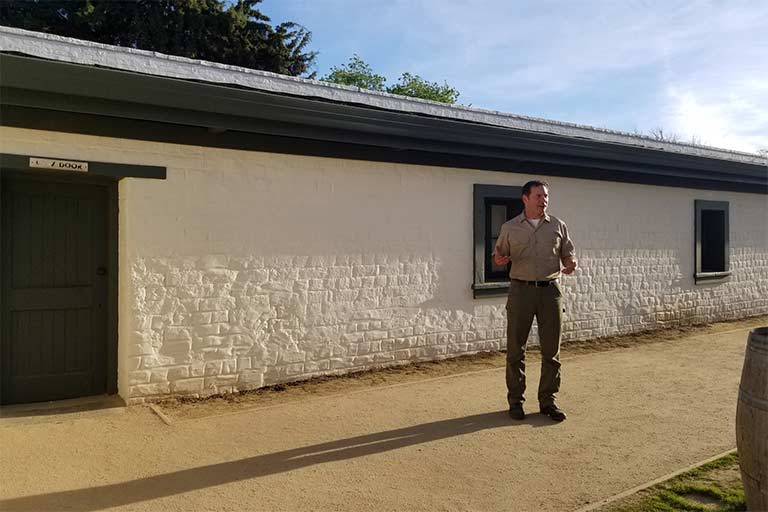
Painting of the Interior Walls (Completed Winter, 2018)
In 2017, Friends of Sutter’s Fort funded this $115,000 project that restored the interior walls of Sutter’s Fort State Historic Park. Once work began , this project took over 6 months to complete. The project was a painstaking process that included repointing mortar, repairing cracks and applying fresh “breathable” paint to protect the surface for important historic preservation purposes.
One of the most significant improvements that this project made was replacing the old blue-grey trim color with a historically accurate green, which was matched by California State Parks restoration specialists.
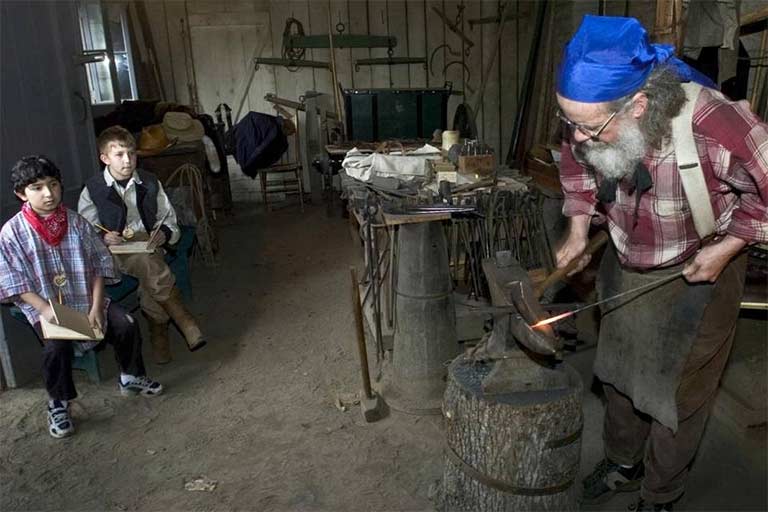
Blacksmith Shop Renovations (Completed Spring, 2017)
In the Spring of 2017, Friends of Sutter’s Fort was able to partner with the Sacramento Pioneer Association to fund a full renovation of the Blacksmith Shop at Sutter’s Fort State Historic Park- the first renovation of the Blacksmith shop since the initial reconstruction in the 1890s. The Sacramento Pioneer Association graciously donated $26,000 for this project.
The project included reworking the chimney, rehabbing the forge/firebox and updating the exhaust ducting. The windows and entrance doors were also stripped, repaired and painted, the walls were cleaned, repaired and painted and the uneven floors were leveled and resurfanced with soil cement so that it was even with the exterior pathways.
While this project was underway, we also funded the cleaning and repairs of all of the Blacksmith shop artifacts and furniture.
Having a skilled blacksmith at the Fort was a real point of pride for John Sutter. Blacksmith skills were in great demand to help transform dark metals into original tools and hardware to be used as shoes for horses, lance heads for soldiers, tires for wagons as well as for making door handles, hinges, latches, and much more. Today, Sutter’s Fort has several talented volunteer docents who interpret the Blacksmith shop, delighting visitors of all ages.
 View the photo album on Facebook
View the photo album on Facebook
Blacksmith shop at Sutter’s Fort to be restored (SacBee.com, July 10, 2016)
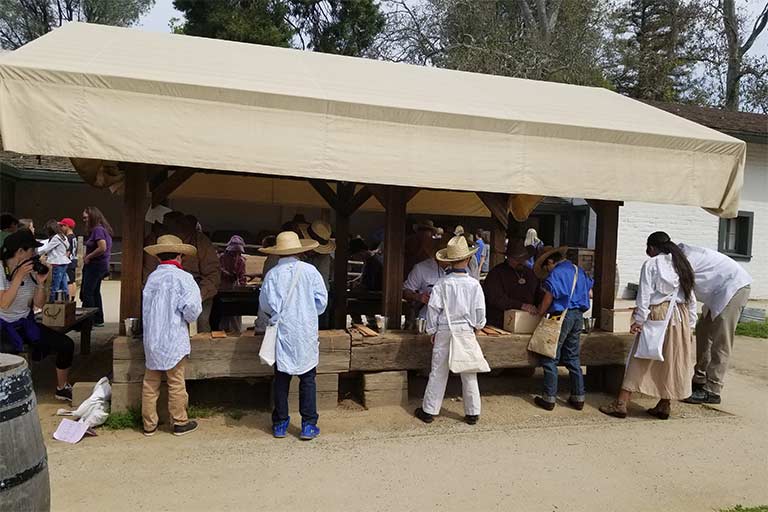
Rebuilding of the Carpenters Ramada (Completed Summer, 2016)
In 2016 Friends of Sutter’s Fort provided funding the California State Parks to rebuild the carpenters ramada, which had been destroyed in a storm. Plans and materials were assembled and precut offsite, and then a dedicated team of volunteers and State Park staff came together to rebuild the ramada in just one day!
The carpenter’s ramada is important for several reasons. First, it allows interpretation of carpentry during Hands on History and other events. Carpentry was an important aspect of life in the 1840s, and Sutter relied on carpenters to build many items at Sutter’s Fort. Carpentry of this period was a complex trade, requiring a great deal of skills and knowledge. The work of the carpenter was closely integrated with everyone’s life. Wood products, from pitchers to beds to wagons to houses, were purchased more or less directly from the carpenter.
One important carpenter at Sutter’s Fort was James Wilson Marshall, who became Captain Sutter’s chief mechanic (Marshall was a Master Coachwright, Journeyman Wheelwright and Millwright.) Later, Marshall went on to become famous for his role in the discovery of gold in Coloma.
The carpenters ramada is also extremely important for the educational programs at Sutter’s Fort. The carpentry station provides opportunities not only to learn about history, but also Science, Technology, Engineering and Math. Most schools who participate in the Environmental Studies or Environmental Living Programs at Sutter’s Fort SHP include a carpentry station, where students learn how to build something using period appropriate tools including hammers and nails.
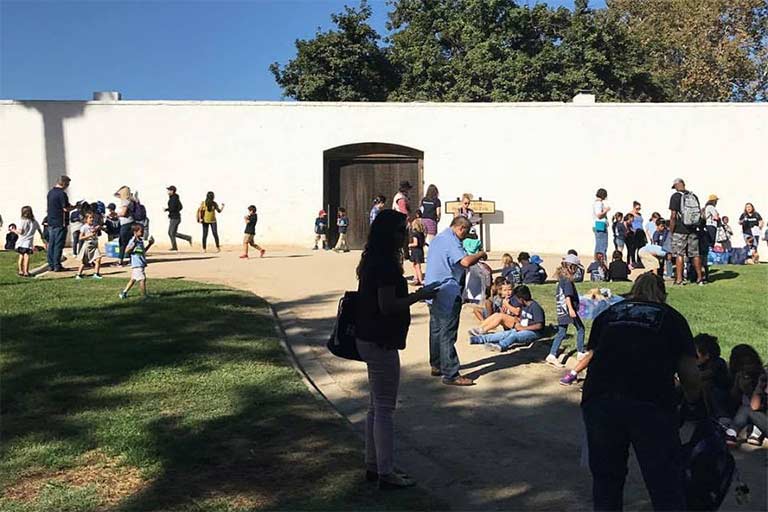
Painting of the Exterior Walls and Restoration of Iconic Wooden Gates (Completed 2016)
The painting and rehabilitation of the exterior walls of Sutter’s Fort was one of the largest restoration projects since it became part of the California State Park System in 1946. This project cost over $600,000 to complete, and took nearly a year to finish.
The historic exterior walls of Sutter’s Fort were rebuilt for the first time in the 1890s in the first restoration project in California, undertaken by the Native Sons of the Golden West. I nthe 1950s, California State Parks resurfaced the walls after damaging vines had been removed.
In 2015, Fair Oaks philanthropist Ron Leineke pledged to donate needed funds to Friends of Sutter’s Fort to restore the historic walls and gates at the Fort. His funding allowed the iconic walls of Sutter’s Fort to be resurfaced.
The painstaking process included repointing mortar, repairing cracks and applying fresh “breathable” paint to protect the surface.
 View the photo album on Facebook
View the photo album on Facebook
Sutter’s Fort to close for major repairs in July (SacBee.com, June 21st, 2015)